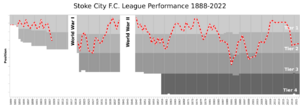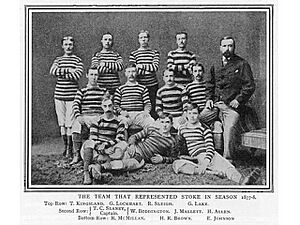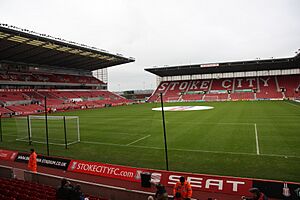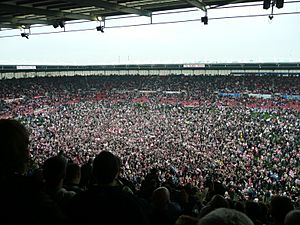History of Stoke City F.C. facts for kids
Stoke City Football Club started as Stoke Ramblers in 1863. This team was formed by students from Charterhouse School who were working as apprentices at the North Staffordshire Railway. The club later dropped "Ramblers" and became Stoke Football Club.
In 1888, Stoke was one of the first twelve teams to create the Football League. The club changed its name one last time in 1925 to Stoke City Football Club. This happened when Stoke-on-Trent became an official city.
In 1997, the club moved to the Britannia Stadium, a modern stadium with 28,383 seats. Before that, they played for 119 years at the Victoria Ground. In the 2007–08 season, Stoke won promotion from the Football League Championship. This meant they moved up to the top league in English football, the Premier League. It was their first time in the top league since the 1984–85 season.
Stoke's biggest trophy win was the 1972 Football League Cup. They beat Chelsea 2–1 in the final at Wembley Stadium. Almost 98,000 fans watched the game. The club also won the Football League Trophy twice, in 1992 and 2000. Their closest call to winning the league title was in the 1946–47 season. They lost on the final day, which cost them the top spot.
Contents
- The Early Days of Stoke City (1863–1888)
- Becoming a Founding Member of the Football League (1888–1900)
- Financial Challenges and a New Start (1900–1919)
- Ups and Downs in the League (1919–1930)
- The Rise of a Legend: Stanley Matthews (1930–1938)
- World War II and a Title Near Miss (1938–1950)
- Relegation and Struggles (1950–1960)
- The Waddington Era (1960–1977)
- From First Division to Third (1977–1990)
- Lou Macari's Two Spells (1990–1997)
- Life at the Britannia Stadium (1997–2008)
- Ten Years in the Premier League (2008–2018)
- Back in the Championship (2018–Present)
- Images for kids
The Early Days of Stoke City (1863–1888)
Stoke Ramblers was formed in 1863 by former students of Charterhouse School. They were apprentices at the North Staffordshire Railway works in Stoke-on-Trent. The team's first recorded match was on October 17, 1868. They played at the Victoria Cricket Club ground and drew 1–1.
Henry Almond, the club's founder and captain, scored their first goal. In 1875, the club moved to Sweetings Field to handle more fans. At first, they only played friendly matches. This changed in 1877 when the Staffordshire Football Association started the County Cup. Stoke won this first competition, beating Talke Rangers 1–0 in the final. They also had their biggest win ever, 26–0 against Mow Cop. Stoke won the County Cup again the next year, proving they were the best club in the area.
In 1878, the club joined with Stoke Victoria Athletic Club and became Stoke Football Club. They moved to the Athletic Club ground, which soon became known as the Victoria Ground. Around this time, they started wearing their famous red and white striped kit. Stoke entered the new Birmingham Association Cup in 1881 but lost to Aston Villa. In the 1882–1883 season, they reached the Staffordshire Senior Cup final but lost to West Bromwich Albion.
Stoke first entered the FA Cup in the 1883–84 season. In 1885, football became professional, and Stoke followed suit that August. Their first FA Cup win was a 10–0 victory over Caernarfon Wanderers in the 1886–87 season.
Becoming a Founding Member of the Football League (1888–1900)
Stoke became one of the twelve founding clubs of the Football League in 1888. Harry Lockett, Stoke's manager, helped create the league and became its first secretary. Stoke struggled in their first two seasons, finishing last both times. They were replaced by Sunderland for a short period.
In the 1890–91 season, Stoke played in the Football Alliance and won the championship. The Football League then expanded, allowing Stoke to rejoin in 1891–92. They stayed in the league for the rest of the decade. In 1897, Horace Austerberry became manager. He led the club to the FA Cup semi-final in 1898–99.
Financial Challenges and a New Start (1900–1919)
Around 1900, Stoke faced money problems. This led to them losing their Football League spot in 1908. However, local business people and fans stepped in to form a new company and buy the club's assets. Stoke then played in the Birmingham & District League.
In 1909, the club played in two leagues: the Birmingham & District League and the Southern League. Stoke won the Southern League in their first year. They continued in both leagues until 1915, when they were allowed back into the Football League. But the First World War stopped the league for four years. It started again in August 1919.
Ups and Downs in the League (1919–1930)
In 1919, the club bought the Victoria Ground. A new stand was built, increasing the stadium's capacity to 50,000. After the Football League restarted, Stoke won promotion from the Second Division in the 1921–22 season. But they were relegated the very next season.
Tom Mather became manager in 1923. Stoke was relegated again in the 1925–26 season. However, they quickly won the Third Division North championship in their first season there. In 1925, Stoke-on-Trent became a city, and the club changed its name to Stoke City Football Club.
The Rise of a Legend: Stanley Matthews (1930–1938)
The 1930s saw the arrival of Stoke's most famous player, Stanley Matthews. Matthews, from Hanley, joined the club as an apprentice. He played his first game at age 17 in March 1932. By the end of the decade, he was an England international and one of the best players in the world.
Matthews first played for England in 1934. Stoke won promotion from the Second Division in the 1932–33 season, winning the championship. Matthews scored his first goal for the club in a 3–1 win against local rivals Port Vale.
By 1934, over 23,000 fans were coming to games on average. This gave manager Tom Mather more money to buy players. But the team was mostly made up of talented local players like Matthews, Tommy Sale, and Freddie Steele. Mather left in 1935, and Bob McGrory, a former player, took over.
In the 1935–36 season, Stoke finished fourth in the Football League First Division. They recorded their biggest league win, 10–3, against West Bromwich Albion in February 1937, with Steele scoring five goals. In April 1937, a record 51,373 fans watched Stoke play Arsenal. Steele's 33 league goals that season is still a club record.
World War II and a Title Near Miss (1938–1950)
Before Second World War started, there were rumors that Stanley Matthews wanted to leave Stoke. But he decided to stay, and the club finished seventh in the 1938–39 season. The war stopped the league for six years.
After the war, the team was strong, with many local players like Matthews, Sale, Steele, and John McCue. Neil Franklin, considered the best centre-half in the country, also played for Stoke. In the 1946–47 season, Stoke almost won the league title. They needed a win in their last game but lost 2–1 to Sheffield United. This meant Liverpool won the title instead. Stanley Matthews left the club for Blackpool shortly before the season ended.
Relegation and Struggles (1950–1960)
The 1950s were tough for Stoke. After avoiding relegation for two seasons, they went down to the Second Division in 1952–53. Bob McGrory, the manager for 17 years, left in 1952. His replacement, Frank Taylor, kept the club in the Second Division but couldn't get them promoted. Stoke came close in the 1954–55 season, missing out by just two points. Taylor was dismissed in 1960 after a poor season.
The Waddington Era (1960–1977)
By 1960, fewer than 10,000 fans were coming to games. Tony Waddington became manager in June 1960. He had been a coach and assistant manager at the club. In his first season, 1960–61, Stoke finished 18th.
Waddington made a big move by bringing back Stanley Matthews, who was 46 years old. Over 35,000 fans came to see Matthews' return. This helped Stoke improve, and they won promotion in the next season, becoming champions. In their first season back in the First Division, 1963–64, Stoke finished in the middle of the table. Matthews also helped the club reach the Football League Cup final in 1964, but they lost to Leicester.
Waddington often signed experienced players. Matthews was knighted in 1965 for his services to football. He played his last league game for Stoke in February 1965, shortly after his 50th birthday. His career lasted 33 years, with 19 years at his home town club. Gordon Banks, England's 1966 World Cup winning goalkeeper, joined Stoke in 1967. Banks was considered the best goalkeeper in the world and helped Stoke stay strong in the First Division. Sadly, Banks had to retire from top-level football in 1972 after losing an eye in a road accident.
Stoke won their first major trophy on March 4, 1972, in the League Cup Final. They beat favorites Chelsea 2–1 at Wembley Stadium. To reach the final, Stoke played 11 games, including four against West Ham United in the semi-final. Stoke also did well in the FA Cup, reaching the semi-finals in both the 1970–71 and 1971–72 seasons, but lost to Arsenal both times.
After George Eastham and Peter Dobing retired, Waddington signed Alan Hudson from Chelsea for £240,000 in 1974. He also bought Geoff Salmons and later paid a world record fee for a goalkeeper, £325,000, to sign Peter Shilton. These new players helped Stoke almost win the league title in 1974–75, but they finished fifth.
The 1970s also saw Stoke play in Europe for the first time. They qualified for the UEFA Cup in 1972–73 because they won the League Cup. They beat Kaiserslautern 3–1 at home but lost the second leg 4–0, losing 5–3 overall. Stoke qualified for the UEFA Cup again in 1974–75 but were knocked out by Ajax on the away goals rule.
In January 1976, a storm damaged the Butler Stand roof. The repairs cost a lot of money, putting the club in financial trouble. To help, Stoke sold Alan Hudson, Mike Pejic, and Jimmy Greenhoff. With a weaker team, relegation became unavoidable in the 1976–77 season. Waddington left the club in March 1977 after 17 years in charge.
From First Division to Third (1977–1990)
George Eastham became manager in March 1977, but Stoke was relegated to the Second Division. Eastham left in January 1978. Stoke then lost to non-league Blyth Spartans in the FA Cup. Alan Durban became the new manager in February 1978. Durban led Stoke to promotion to the First Division in his first full season, 1978–79. After keeping the club in the First Division, Durban left for Sunderland in 1981.
Richie Barker took over in 1981. He signed Mickey Thomas and Mark Chamberlain. Chamberlain, a winger, was very successful and played eight times for England while at Stoke. Barker was sacked in his second season, 1983–84. The new manager, Bill Asprey, brought back veteran Alan Hudson. Stoke improved and avoided relegation on the final day.
The next season was very bad for Stoke. They finished with only 17 points and just three wins. This was the lowest points total in the top league for 21 years. Mick Mills became player-manager in 1985. He kept the club in the Second Division. In 1986–87, Stoke reached fourth place, including a 7–2 win over Leeds United. But their form dropped, and they finished eighth. Mills was unable to get the team promoted and was sacked in November 1989.
Alan Ball became the new manager. Peter Coates became the club's chairman in 1989. Ball struggled in his first season, 1989–90, and Stoke were relegated to the third tier of English football. The 1990–91 season was the first time Stoke played at this level in 63 years. Ball left in February 1991, and Stoke finished 14th, their lowest league position ever.
Lou Macari's Two Spells (1990–1997)
Lou Macari became manager in May 1991. Stoke improved right away, almost getting promoted in his first season. They also won the Football League Trophy in 1992, beating Stockport County 1–0 at Wembley. Mark Stein scored the winning goal.
The next season, 1992–93, Stoke won promotion from the third tier, becoming league champions. Stein scored 26 goals that season. Macari left in October 1993 to manage Celtic, and Stein also left for Chelsea.
Joe Jordan took over but left less than a year later. Stoke then brought back Lou Macari. Despite excitement about his return, they only finished in the middle of the table in 1994–95. The 1995–96 season started badly, but signing striker Mike Sheron helped turn things around. Stoke finished fourth but lost in the play-off semi-final.
The 1996–97 season saw Mark Stein return on loan. Stoke started well but dropped to 12th place. Sheron was sold in 1997 for a club record fee. Macari left at the end of the season. His last game was the final league match at the Victoria Ground.
Life at the Britannia Stadium (1997–2008)
The 1997–98 season saw Stoke move to their new home, the Britannia Stadium. They had spent 119 years at the Victoria Ground. Chic Bates, Macari's assistant, became manager. But the team struggled, falling towards the relegation zone. Bates was replaced by Chris Kamara in January 1998, but he also couldn't improve things. Alan Durban returned as manager for the rest of the season, but Stoke was relegated from the First Division.
Brian Little took charge for the 1998–99 season. Stoke started well, winning six games in a row and holding first place until December. But their form dropped, and Little left at the end of the season. His replacement, Gary Megson, only lasted four months. He left after an Icelandic group, Stoke Holding, bought most of the club. The new owners appointed Stoke's first foreign manager, Icelander Gudjon Thordarson, in November 1999.
Stoke won the Football League Trophy in the 1999–2000 season, beating Bristol City 2–1 at Wembley. But they lost in the play-off semi-finals, staying in the third tier. They reached the play-offs again in the 2000–01 season but lost to Walsall.
Thordarson finally achieved promotion in 2001–02. Stoke beat Cardiff City in the semi-final and then Brentford 2–0 in the final at the Millennium Stadium. This secured promotion. But Thordarson was sacked just five days later.
Steve Cotterill became manager before the 2002–03 season but quit after only four months. Tony Pulis was then appointed as Stoke's new manager. Pulis kept Stoke from being relegated with a 1–0 win on the final day of the season. He was sacked at the end of the 2004–05 season after a disagreement with the owners.
Dutch manager Johan Boskamp took over. He broke the club's transfer record by signing Sambegou Bangoura for about £1 million. Belgium international Carl Hoefkens also joined and became the Fans' Player of the Year. Boskamp's team was inconsistent, and he left at the end of the 2005–06 season.
On May 23, 2006, former chairman Peter Coates bought Stoke City. He chose Tony Pulis to return as manager in June 2006. Pulis led Stoke close to a play-off spot, finishing eighth in the 2006–07 season. In June 2007, Peter Coates bought the Britannia Stadium from the City Council.
Ten Years in the Premier League (2008–2018)
Stoke won automatic promotion to the Premier League on the final day of the 2007–08 season, finishing second in the Championship. In July 2008, the club broke their transfer record again, buying striker Dave Kitson for £5.5 million. Many thought Stoke would be relegated after losing their first Premier League game. But they won their first home game at the Britannia Stadium against Aston Villa with a late goal from Mamady Sidibe. Stoke finished 12th in their first Premier League season.
Manager Pulis signed Robert Huth and Tuncay Şanlı to help the club stay in the Premier League. Stoke finished 11th in the 2009–10 season, securing a third season in the top league. Pulis strengthened his squad for the 2010–11 season by signing Kenwyne Jones for a club record £8 million.
In the 2010–11 season, Stoke beat West Bromwich Albion 3–0 away. This was their biggest away win in the Premier League and their first time winning three top-flight matches in a row since 1984. Stoke reached the FA Cup semi-final for only the fourth time in their history. They beat Bolton Wanderers 5–0 to reach their first FA Cup Final in 148 years. However, they lost the final 1–0 to Manchester City. By reaching the final, Stoke qualified for the 2011–12 UEFA Europa League.
On July 28, 2011, Stoke beat Hadjuk Split in the Europa League, their first European appearance in 37 years. They reached the group stage and then played Spanish giants Valencia in the round of 32. Stoke lost both legs 1–0, ending their European journey. Stoke finished the 2011–12 season in 14th place. The 2012–13 season saw little progress, and Pulis left the club in May 2013.
Mark Hughes replaced Pulis. Hughes led Stoke to a ninth-place finish in 2013–14, their highest Premier League position. Stoke finished ninth again in 2014–15, ending with a 6–1 win against Liverpool. Despite buying expensive players like Xherdan Shaqiri and Giannelli Imbula, Stoke finished ninth for a third season running in 2015–16. Stoke's performance declined in 2016–17, finishing 13th. The decline continued in 2017–18, and Mark Hughes was sacked in January 2018. Paul Lambert tried to keep Stoke up, but they were relegated, ending their ten-year stay in the Premier League.
Back in the Championship (2018–Present)
Gary Rowett became manager for the 2018–19 season, aiming for a quick return to the Premier League. But despite spending a lot on new players, the team's performance was disappointing, and Rowett lost his job in January 2019. Nathan Jones took over but only won three of the remaining matches. Stoke finished 16th.
Jones brought in ten new players for the 2019–20 season, but the team had their worst start to a league season, not winning any of their first ten games. Jones was sacked in November 2019, and Michael O'Neill became manager. Results improved under O'Neill, and Stoke moved away from the relegation zone. The season was paused in March 2020 due to the COVID-19 pandemic. Stoke won four of their last nine matches and finished 15th.
The entire 2020–21 season was played without fans, and Stoke finished 14th. In 2021–22, Stoke started well but a poor second half of the season saw them finish 14th again. A slow start to the 2022–23 season led to O'Neill's dismissal in August 2022. Alex Neil replaced him.
Images for kids








